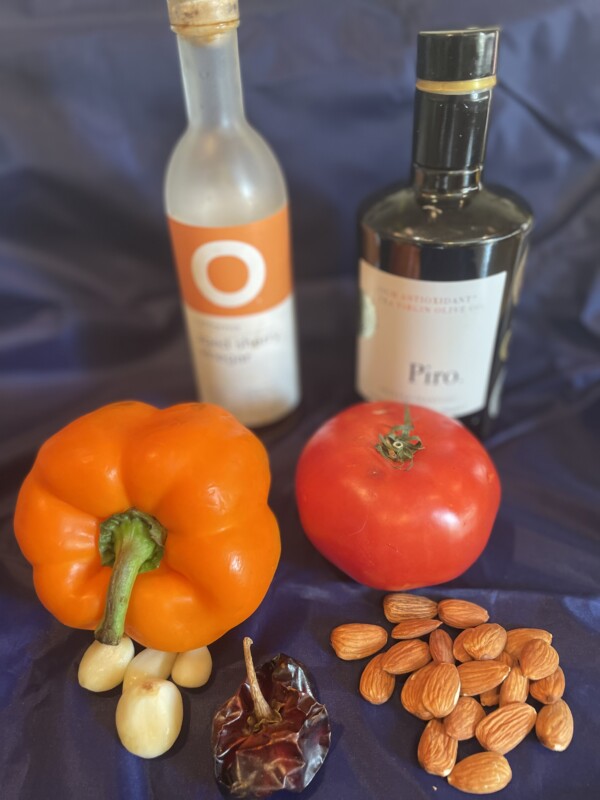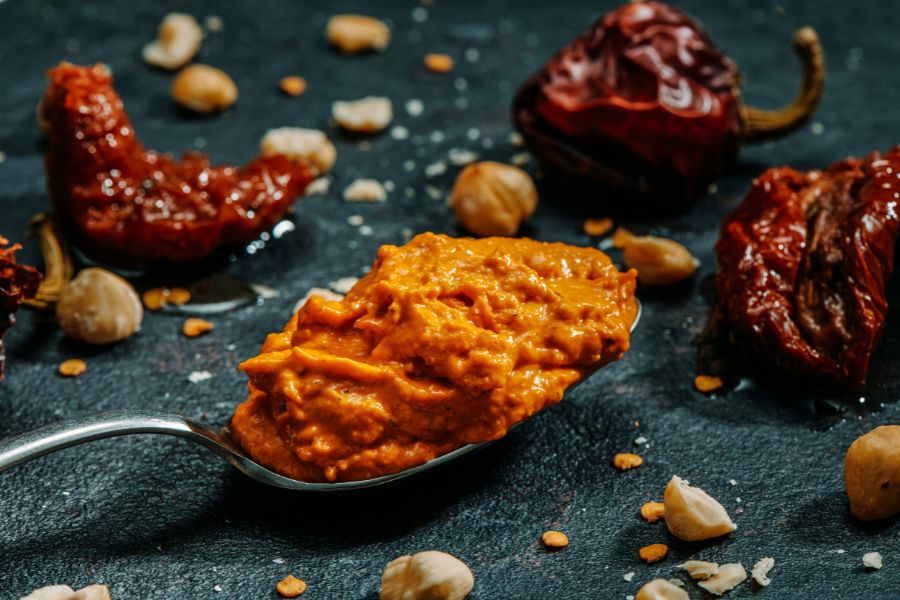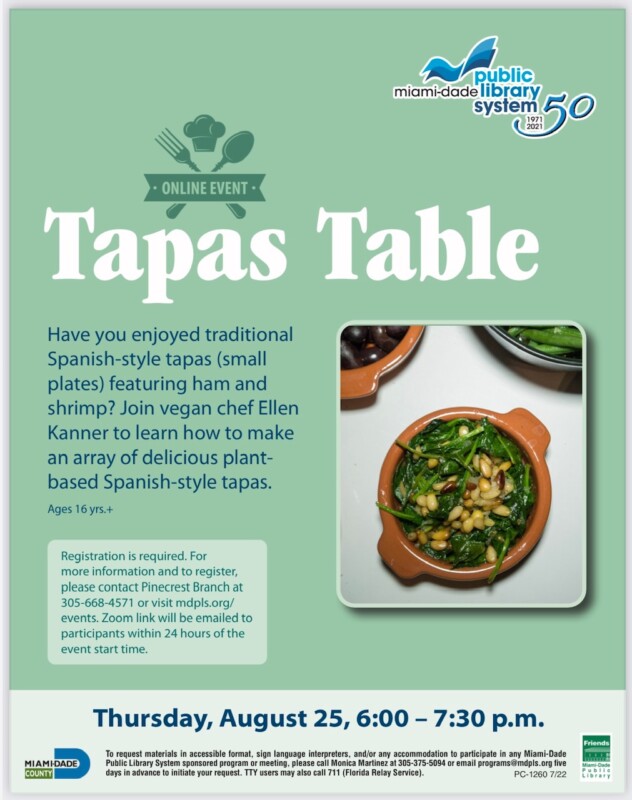Join me 6pm ET this Thursday for my free, virtual Tapas Table cooking class, hosted by Miami-Dade Public Library’s Pinecrest Branch. Register here.
Summer means grilling season, and if you love grilled vegetables — I do — Romesco sauce is the accessory you need. As a dip, dab, or dollop, this Catalan sauce coaxes out the natural luster of any vegetable. Romesco has a rosy terracotta hue, but it’s more than just pretty on a plate. It’s all the bold flavors of Spain — tomatoes, garlic, peppers, olive oil, and almonds — together in one creamy (but creamless) sauce. It’s what summer tastes like to me.
Summer in Spain means calcot harvest. Calcots, related to scallions and spring onions, have been grown in Catalonia since the 1800s. They’re long, slender, and bright green. Freshly harvested, they have an oniony bite but a natural sweetness, too. They’re typically served grilled with a bowl of Romesco, so you can dredge your calcots with sauce to your heart’s content. This is a summer tradition that invites abandon (and maybe pitchers of sangria, too). Best not to wear your favorite shirt, lest there be splatters.

Make Romesco, and let the flavors of Spain come to you. Try it with:
- grilled or roasted summer produce like eggplant and zucchini, and peppers
- year’ round favorites like grilled mushrooms, carrots onions, broccoli and cauliflower
- fresh raw ripe tomatoes, crisp celery, crunchy radishes
- I haven’t tried slathering it on corn, but what could be bad?
- It’s a winner slathered on crusty bread
- it’s a meant-to-be topping for roasted potatoes
- On warm beans like plump, creamy limas? Yassss.
- In fact, I think I’ve just created the perfect sandwich — toasted grainy bread, layers of roasted vegetables, topped with thinly sliced radishes and tomato, maybe a few beans, mashed, and a blanket of Romesco. Not tidy, but terrific.
- And yeah, a pitcher of chilled sangria would make a mighty fine accompaniment.
How to make Romesco sauce:
- Heat oven to 375 degrees. Pour nuts onto a small rimmed baking sheet and toast until they darken slightly and smell buttery, about 10 minutes. Set aside to cool.
- Meanwhile, set chile in a small bowl and add enough boiling water to cover. When cool, drain pepper. Remove and discard seeds and stem.
- Drop bread, garlic, chile and almonds into a food processor or blender. Process for a minute or so, until a thick paste forms, scraping the sides. Add the tomatoes, vinegar, paprika and olive oil and pulse.
- The sauce should be of a hummus-like consistency, thick but not gluey. Add a tablespoon or two of water if it seems too dry. Add sea salt to taste.

Romesco Tips:
- A food processor or high-speed blender makes quick work of this.
- A teensy splash of sherry vinegar gives Romesco just the right sparkle of acidity.
- Tomato adds umami.
- The chile and garlic are mild, adding a deep, almost smoky note.
- If you love smokiness, substitute the sweet paprika for smoked paprika.
- Use extra virgin olive oil for best results.
- Romesco’s not just about indulgence. The addition of stale bread gives Romesco oomph and body, and is a delicious way to make use of what you have and reduce waste.
- Traditionally, Romesco is made with roasted hazelnuts. Use ‘em if you’ve got ‘em. I substitute roasted blanched almonds.
- they’re cheaper
- they’re more accessible
- you don’t have to mess with removing hazelnuts’ papery skins — such a nuisance.
- But okay, for optimal Romesco, you should blanch the almonds before toasting, both for looks and flavor. Cheer up, peeling the nuts’ dark, slightly tannic skin is fun, fast, and easy to do, once you know the trick.
- To blanch almonds:
- Pour almonds into a small heatproof bowl.
- Cover with boiling water and leave for 15 minutes. Drain.
- Pinch almonds between your fingers. Skins will slip off off, leaving you perfect, pale bare nut kernels.
- Allow Romesco to chill, covered, in the refrigerator for a few hours, to let the flavors blend.
- Best served at room temperature.
- My best tip for you is this — join me 6pm ET this Thursday for my free, virtual Tapas Table cooking class, hosted by Miami-Dade Public Library’s Pinecrest Branch. We’ll keep the Spanish flavors going. Register here.


Romesco Sauce
Ingredients
- ⅔ cup blanched whole almonds
- 1 mild dried chile such as an ancho
- 1 slice baguette torn into pieces
- 3 garlic cloves peeled
- 1-2 ripe plum tomatoes or 2/3 cup canned fire-roasted tomatoes drained
- 1 teaspoon sherry vinegar or red wine vinegar
- 1 ½ teaspoons sweet paprika
- ⅓ cup olive oil
- Sea salt to taste
Instructions
- Heat oven to 375 degrees. Pour nuts onto a small rimmed baking sheet and toast until they darken slightly and smell buttery, about 10 minutes. Set aside to cool.
- Meanwhile, set chile in a small bowl and add enough boiling water to cover. When cool, drain pepper. Remove and discard seeds and stem.
- Drop bread, garlic, chile and almonds into a food processor or blender. Process for a minute or so, until a thick paste forms, scraping the sides. Add the tomatoes, vinegar, paprika and olive oil and pulse.
- The sauce should be of a hummus-like consistency, thick but not gluey. Add a tablespoon or two of water if it seems too dry. Add sea salt to taste.
More bold flavors of Spain
- Cool, creamy ajo blanco
- Rich, umami chickpeas with saffron
- Turn leftover rice into rice pudding
- Broke Bank Vegan‘s tortilla espanola, made with chickpea flour, no eggs
- Brilliant chef and big-hearted humanitarian José Andrés offers stylish skewers of watermelon and tomatoes, what a cool (and cooliing!) idea!
- Garlic and chocolate? Believe it, especially when it comes from Latinx chef and food historian, Marisel Presilla.

Leave a Reply